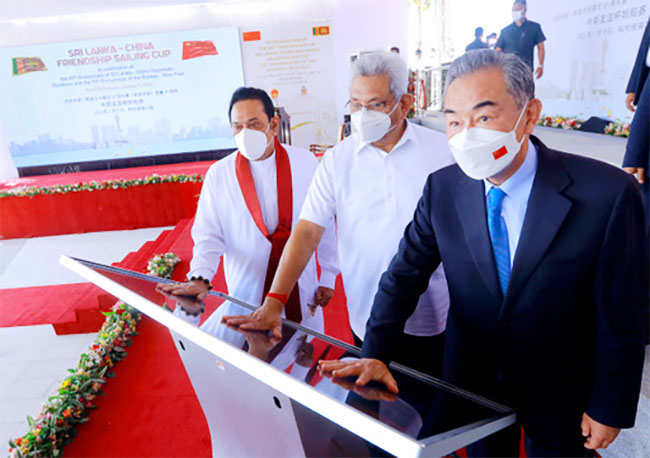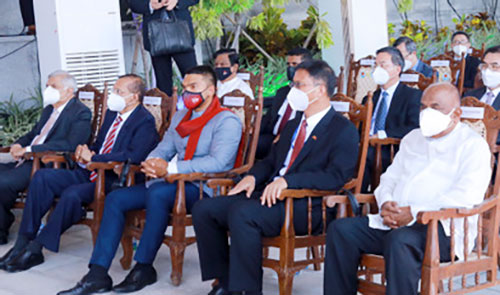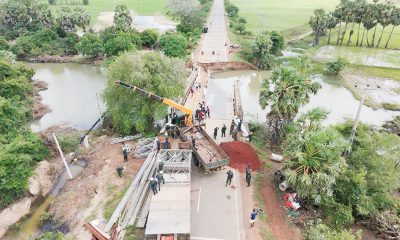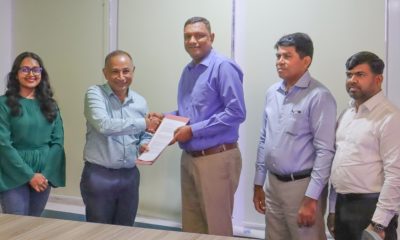Midweek Review
Post-war foreign relations: A diplomatic quagmire for Lanka

By Shamindra Ferdinando
Chinese Ambassador to Colombo Qi Zhenhong seems quite confident of Sri Lanka’s capacity to overcome the current economic turmoil the ruling Sri Lanka Podujana Peramuna (SLPP) is experiencing.
The top Chinese envoy, at an informal meeting with a selected group of print media journalists on Sunday (09), soon after the departure of Chinese State Councillor and Foreign Minister Wang Yi, asserted that the crisis was temporary. Ambassador Qi Zhenhong declared that as Sri Lanka had overcome far bigger challenges the country wouldn’t be overwhelmed by the current challenge in debt servicing. The meet took place at the King Emperor Suite of the Galle Face Hotel
Wang departed following high level political talks with the Sri Lankan leadership. President Gotabaya Rajapaksa, Premier Mahinda Rajapaksa and Chinese FM Wang inaugurated the Sri Lanka-China Sailing Cup 2022 at the Port City to celebrate the 65th anniversary of China and Sri Lanka diplomatic relations and the 70th anniversary of the Rubber-Rice pact. Interestingly, former Premier and UNP leader Ranil Wickremesinghe, MP, was among the invitees. Wickremesinghe, whose government delayed the Port City project by about one and half years, sat next to Foreign Minister Prof. G. L. Peiris, who returned from an official visit to Seoul the previous day.
Is Ambassador Qi Zhenhong right in his assessment? Had there been far bigger crises in the recent past that threatened to overwhelm Sri Lanka? Perhaps Ambassador Qi Zhenhong is right in his appraisal. Maybe, he is not. Having joined the Chinese Foreign Service in 1988, Ambassador Qi Zhenhong took over the Chinese diplomatic mission in Colombo about a year ago at the height of Covid-19 eruption.
Amidst a simmering row with the Sri Lankan government over the rejection of an allegedly contaminated Chinese carbonic fertiliser consignment, Ambassador Qi Zhenhong undertook a three-day visit (Dec 15-17, 2021) to the Jaffna peninsula.
Colombo-based The Hindu correspondent, Meera Srinivasan, in a story dated Dec 26, 2021, headlined ‘Chinese Ambassador’s visit to Jaffna sparks concern, commentary in Sri Lanka’, described the visit as an intensification of geopolitical contest between India and China. Qi Zhenhong underscored China’s right to engage people in any part of Sri Lanka. Responding to media at the Emperor’s Suite, Qi Zhenhong pointed out: “Jaffna is in the northern part of Sri Lanka, not south of any other country.”
Ambassador Qi visited the Jaffna public library and the Adam’s Bridge, a row of limestone shoals across the narrow Palk Strait between Mannar and Rameswaram in Tamil Nadu.
The Ambassador visited a seafood factory in Mannar district, built with Chinese investment, and a sea cucumber farm in Jaffna.
The Chinese entry into Sri Lanka and the gradual expansion of its role here should be examined against the backdrop of Indian-funded terrorism project that destabilised the entire country. The Sri Lanka Army couldn’t have withstood the terrorist firepower if not for military assistance provided by China, Pakistan, Russia and Israel during the early stages of the conflict. Having paid a heavy price for destabilising its smaller neighbour, India allowed the annihilation of separatist Tamil conventional military capability in 2009. The eradication of terrorism has paved the way for geopolitical contest between the two Asian nuclear powers here. Both China and India seemed confident in pursuing their agendas as the cash-strapped SLPP government struggled on multiple fronts. The deterioration of Sri Lanka’s economy as a result of the Covid-19 pandemic delivering a devastating blow to its once vibrant tourism industry and expatriate worker remittances, (both raked in huge amounts of foreign exchange), as well as waste, corruption and mismanagement at every level appeared to have facilitated anti-Sri Lanka foreign projects much to the dismay of the vast majority of people. Sri Lanka seems to be at the mercy of foreign powers.
Superpower politics
Chinese and Indian investments as well as relations with political parties here cannot be discussed leaving out the ongoing battle between China and the US-led grouping. India is part of the latter. South Korea is also in that group though it has so far refrained from joining the four-nation ‘Quad’ comprising the US, India, Japan and Australia. Post-war Sri Lanka is in a dicey situation. In spite of overcoming terrorism 12 years ago, Sri Lanka is under tremendous pressure from both parties as each seeks investment opportunities advantageous to them.
Recently, Fisheries Minister Douglas Devananda expressed concerns over China and India seeking to invest in the Point Pedro fisheries harbour. Devananda, the leader of the Eelam People’s Democratic Party (EPDP), one of the smaller terrorist groups, that took to the democratic path long before the LTTE terror mechanism was annihilated and primarily active in the Northern region vowed not to allow China to exploit the Northern population. Obviously Devananda is playing politics. The Fisheries Minister cannot take a view contrary to that of the Rajapaksas.
Pathfinder, an organisation founded by Sri Lanka’s High Commissioner in New Delhi, Milinda Moragoda, in its latest report titled ‘Sri Lanka has no room to maneuver’ carried in the January 10 edition of The Island warns of a catastrophe unless the government adopts remedial measures, immediately. While appreciating the arrangement Sri Lanka has reached with India to meet immediate challenges, Pathfinder recommended (i) restructuring of external debt (ii) an arrangement with the International Monetary Fund (iii) mobilisation of ‘bridging finance’ to meet the external financing gap up to June 2022.
Recent US and Indian investments in the energy sector should be viewed against the backdrop of much economically weakened Sri Lanka. The controversial energy deals with US-based New Fortress Energy, and Indian Oil Corporation Limited finalised on Sept 17, 2021 and January 5, 2022, respectively, generated much public interest. The latter was finalised just days before the Chinese Foreign Minister’s visit. Both agreements have been challenged in the Supreme Court. The SC is in the process of hearing several petitions against the US energy deal whereas Ven. Wakmulle Uditha Thera of Nayigala Raja Mahaviharaya, Agrahara, Weeraketiya, filed a fundamental rights petition against the agreement on Trincomalee Oil Tank Farm. The Ven. Thera is believed to be acting on behalf of the JVP, the only party to move court against both the US and Indian investments.
Energy Minister Udaya Gammanpila, who along with Cabinet colleagues, Vasudeva Nanayakkara and Wimal Weerawansa moved SC against US energy deal that came through the backdoor, in a booklet titled ‘Regaining Trincomalee Oil Tank Farm’ declared that he gave the ‘strategic leadership’ to the project. In spite of accusations of a sellout and betrayal by many quarters, including the Federation of National Organisations, led by Dr. Gunadasa Amarasekera, which demanded a thorough investigation. Attorney-at-law Gammanpila defended the latest agreement. The booklet released by the Energy Ministry contained a letter dated July 29, 1987 signed by the then Indian Prime Minister Rajiv Gandhi that dealt with the Trincomalee oil tank farm, President JRJ’s response, an agreement finalised on Feb 7, 2003, during Ranil Wickremesinghe’s premiership, a Memorandum of Understanding (MoU) on economic projects signed in 2017 also during Wickremesinghe’s premiership. What really surprised the public was that though the Energy Ministry compared the 2017 MoU with the recently finalised agreement, the ministry quite conveniently left the January 5 agreement out of the booklet. The ministry may claim that the agreement couldn’t be included as at the time of the releasing of the booklet, it hadn’t been signed. Perhaps, the printing of the booklet should have been delayed till the finalisation of the agreement.
Declaring the project received political guidance from President Gotabaya Rajapaksa and Prime Minister Mahinda Rajapaksa, the Energy Ministry revealed the identities of the two negotiating teams. Accordingly, the Sri Lankan delegation comprised Lalith Vidanagamage, Advisor, Energy Ministry, Buddhika Madihahewa, Managing Director, CPC, Mrs. Hasitha Paragahagoda, Legal Officer, Energy Ministry and Nalin Beligaswatta, Research Officer, Energy Ministry.
The Energy Ministry also named the Indian negotiating team. Deputy High Commissioner Vinod K. Jacob has led the Indian delegation that included Dr. Rakesh Pandey, Head of Commerce, Indian HC, Ms Irina Thakur, First Secretary, Commerce and Cultural Affairs and Manoj Gupta, Managing Director, LIOC.
The Trincomalee Oil Tank Farm comprised two sections (i) Lower Tank Farm and (ii) Upper Tank Farm spread over 827 acres of land.
One cannot forget the circumstances India forced the Indo-Lanka Accord on the latter. That agreement finalised at the height of the US-Soviet cold war encompassed the Trincomalee Oil Tank Farm. Today, US-India relations have reached zenith whereas at the time of the Indo-Lanka Accord India was seen as being much closer to the Soviet Union and constantly feared the US using Sri Lanka as a platform to destabilise the country. The letters exchanged between Rajiv Gandhi and JRJ agreed on the restoration and operation of the Trincomalee Oil Tank Farm as a joint venture. With the latest agreement, India has consolidated its position in the strategic port city of Trincomalee close on the heels of politically influential Adani Group’s investment at the Colombo port. Gujarat-headquartered company signed a Build, Operate, Transfer (BOT) agreement with Sri Lanka’s largest listed company John Keells Holdings and the Sri Lanka Ports Authority (SLPA) to jointly develop the Colombo West International Container Terminal (CWICT) at the Colombo Port, situated amidst one of the busiest shipping routes in the world. China has secured a terminal of its own during the previous Rajapaksa administration as the war was raging with hardly any other investor showing interest and during the Yahapalana administration won a 99-year lease on the Hambantota port. Controversy surrounds the Hambantota port deal, too. Arjuna Ranatunga, who had served as the Ports and Shipping Minister at that time had to give up the portfolio as he didn’t agree with the terms. The then President Maithripala Sirisena and Premier Ranil Wickremesinghe brought in SLFPer Mahinda Samarasinghe as the Ports and Shipping Minister to put the finishing touches to it. Having finalised the agreement in 2017, Samarasinghe switched his allegiance to the SLFP in the run-up to the last parliamentary election in August 2020. The one-time UNPer recently gave up his Kalutara District parliamentary seat to receive appointment as Sri Lanka’s Ambassador in Washington.
 Former PM Wickremesinghe, FM Prof. Peiris, Minister Namal Rajapaksa and Chinese Ambassador to Colombo Qi Zhenhong at the launch of Sri Lanka China Friendship Sailing Cup at the Port City last Sunday (pics courtesy PM Media)
Former PM Wickremesinghe, FM Prof. Peiris, Minister Namal Rajapaksa and Chinese Ambassador to Colombo Qi Zhenhong at the launch of Sri Lanka China Friendship Sailing Cup at the Port City last Sunday (pics courtesy PM Media)
Wijeyadasa strikes discordant note
In spite of China and Sri Lanka enjoying excellent relations and the latter regularly referring to China as an all-weather friend, there had been a number of contentious issues. The Island had an opportunity to raise some of them with Ambassador Qi Zhenhong during last Sunday’s meeting. Reference was made to accusations made by the then Finance Minister Ravi Karunanayake as regards China taking advantage of Sri Lanka, dispute over contaminated carbonic fertiliser consignment that had to be settled by paying USD 6.7 mn to the Chinese firm concerned and SLPP lawmaker Wijeyadasa Rajapakse’s fiery letter to the Chinese President Xi Jinping. There hadn’t been a previous instance of a lawmaker writing to the Chinese leader through its Ambassador in Colombo. Ambassador Qi Zhenhong dismissed Rajapakse’s concerns over China changing its strategy vis-a-vis Sri Lanka in the wake of the high profile ‘One Belt One Road’ (OBOR) project meant to improving connectivity and cooperation among multiple countries spread across the continents of Asia, Africa, and Europe. One-time Justice Minister and former President of the Bar Association of Sri Lanka (BASL) accused China of following an agenda intended to destroy Sri Lanka’s relations with the US, the UK, India, Japan, Korea, Australia and in time to come Russia.
Lawmaker Rajapakse’s stand cannot be examined without taking his call during the previous administration to rescind the Sri Lanka-China agreement on the Hambantota port through the intervention of the Parliament. That call was made in his capacity as a UNP Member of Parliament, whereas he wrote the January 3 dated letter as an SLPP lawmaker.
MP Rajapakse accused China of ruining Sri Lanka’s economy to facilitate their project. The former Justice Minister seemed to have no issue with Quad members, the UK and Korea. Quad members never stood by Sri Lanka at the Geneva-based United Nations Human Rights Council (UNHRC) whereas Western powers brazenly pursued a policy detriment to Sri Lanka. They either voted against Sri Lanka or skipped the vote as in the case of Japan regardless of the Comprehensive Partnership the two countries entered into in Oct 2015. Obviously, Japan lacked the political will to go against the US wishes at the Geneva HRC, whereas Seoul voted against Colombo. On the basis of the Geneva process, the Sri Lankan military is being targeted by the US and some of her allies as part of the overall campaign directed at Sri Lanka.
Regardless of Sri Lanka’s close relations with China, the accusations made by MP Rajapakse cannot be dismissed lightly. The MP issued a warning over possible Chinese investments under the ‘Selendiva’ project, having questioned the investments on the Colombo Port, South Terminal, Coal-fired power plant complex at Norochcholai, International Airport at Mattala, Lotus Tower (Nelum Kuluna) in Colombo, Lotus Theatre (Nelum Pokuna) in Colombo, International Cricket Stadium at Suriyawewa and International Conference Hall in Hambantota. Alleging China created a debt trap, lawmaker Rajapakse said that he lost his portfolio during the Yahapalana administration as he opposed the Hambantota port deal. The copies of MP Rajapakse’s explosive letter have been sent to the President, Prime Minister, Speaker, Most Venerable High Prelates, the Archbishop Colombo, Foreign Minister, Chinese Ambassador in Sri Lanka and Colombo-based High Commissioners and the Ambassadors of the other countries.
Can the SLPP government afford to ignore Wijeyadasa Rajapakse’s actions, particularly against the backdrop of stripping Susil Premjayantha of his portfolio over criticism of the government? Similarly, can Ministers Vasudeva, Wimal and Udaya get away after having challenged their Cabinet colleagues over the US energy deal? The government needs to address these issues as the ruling coalition as well as other political parties represented in Parliament struggle to come to terms with a rapidly changing situation. Avoiding Chinese as well as Western moves and that of India seem a herculean task for Sri Lanka, trying to walk the diplomatic tightrope.
During the Yahapalana administration, the US pushed for three agreements, namely ACSA (Access and Cross Servicing Agreement), SOFA (Status of Forces Agreement) and MCC (Millennium Challenge Corporation (MCC) Compact. On the approval of President Sirisena, the government signed ACSA in August 2017 though the remaining agreements couldn’t be finalised. No one can forget how Premier Ranil Wickremesinghe authorised one-sided CFA (Ceasefire Agreement) or the Sirisena-Wickremesinghe duo allowed the Singapore Sri Lanka Free Trade Pact. If those in power and the Opposition are genuinely interested in protecting national assets, they’ll agree on a political mechanism to reach consensus on agreements with external powers/foreign parties.
Midweek Review
Year ends with the NPP govt. on the back foot

The failure on the part of the Janatha Vimukthi Peramuna (JVP)-led National People’s Power (NPP) government to fulfil a plethora of promises given in the run up to the last presidential election, in September, 2024, and a series of incidents, including cases of corruption, and embarrassing failure to act on a specific weather alert, ahead of Cyclone Ditwah, had undermined the administration beyond measure.
Ditwah dealt a knockout blow to the arrogant and cocky NPP. If the ruling party consented to the Opposition proposal for a Parliamentary Select Committee (PSC) to probe the events leading to the November 27 cyclone, the disclosure would be catastrophic, even for the all-powerful Executive President Anura Kumara Dissanayake, as responsible government bodies, like the Disaster Management Centre that horribly failed in its duty, and the Met Department that alerted about the developing storm, but the government did not heed its timely warnings, directly come under his purview.
The NPP is on the back foot and struggling to cope up with the rapidly developing situation. In spite of having both executive presidency and an overwhelming 2/3 majority in Parliament, the government seems to be weak and in total disarray.
The regular appearance of President Dissanayake in Parliament, who usually respond deftly to criticism, thereby defending his parliamentary group, obviously failed to make an impression. Overall, the top NPP leadership appeared to have caused irreparable damage to the NPP and taken the shine out of two glorious electoral victories at the last presidential and parliamentary polls held in September and November 2024 respectively.
The NPP has deteriorated, both in and out of Parliament. The performance of the 159-member NPP parliamentary group, led by Prime Minister Dr. Harini Amarasuriya, doesn’t reflect the actual situation on the ground or the developing political environment.
Having repeatedly boasted of its commitment to bring about good governance and accountability, the current dispensation proved in style that it is definitely not different from the previous lots or even worse. (The recent arrest of a policeman who claimed of being assaulted by a gang, led by an NPP MP, emphasised that so-called system change is nothing but a farce) In the run-up to the November, 2024, parliamentary polls, President Dissanayake, who is the leader of both the JVP and NPP, declared that the House should be filled with only NPPers as other political parties were corrupt. Dissanayake cited the Parliament defeating the no-confidence motions filed against Ravi Karunanayake (2016/over Treasury Bond scams) and Keheliya Rambukwella (2023/against health sector corruption) to promote his argument. However, recently the ongoing controversy over patient deaths, allegedly blamed on the administration of Ondansetron injections, exposed the government.
Mounting concerns over drug safety and regulatory oversight triggered strong calls from medical professionals, and trade unions, for the resignation of senior officials at the National Medicines Regulatory Authority (NMRA) and the State Pharmaceutical Corporation (SPC).
Medical and civil rights groups declared that the incident exposed deep systemic failures in Sri Lanka’s drug regulatory framework, with critics warning that the collapse of quality assurance mechanisms is placing patients’ lives at grave risk.
The Medical and Civil Rights Professional Association of Doctors (MCRPA), and allied trade unions, accused health authorities of gross negligence and demanded the immediate resignation of senior NMRA and SPC officials.
MCRPA President Dr. Chamal Sanjeewa is on record as having said that the Health Ministry, NMRA and SPC had collectively failed to ensure patient safety, citing, what he described as, a failed drug regulatory system.
The controversy has taken an unexpected turn with some alleging that the NPP government, on behalf of Sri Lanka and India, in April this year, entered into an agreement whereby the former agreed to lower quality/standards of medicine imports.
Trouble begins with Ranwala’s resignation
The NPP suffered a humiliating setback when its National List MP Asoka Ranwala had to resign from the post of Speaker on 13 December, 2024, following intense controversy over his educational qualification. The petroleum sector trade union leader served as the Speaker for a period of three weeks and his resignation shook the party. Ranwala, first time entrant to Parliament was one of the 18 NPP National List appointees out of a total of 29. The Parliament consists of 196 elected and 29 appointed members. Since the introduction of the National List, in 1989, there had never been an occasion where one party secured 18 slots.
The JVP/NPP made an initial bid to defend Ranwala but quickly gave it up and got him to resign amidst media furor. Ranwala dominated the social media as political rivals exploited the controversy over his claimed doctorate from the Waseda University of Japan, which he has failed to prove to this day. But, the JVP/NPP had to suffer a second time as a result of Ranwala’s antics when he caused injuries to three persons, including a child, on 11 December, in the Sapugaskanda police area.
The NPP made a pathetic, UNP and SLFP style effort to save the parliamentarian by blaming the Sapugaskanda police for not promptly subjecting him for a drunk driving test. The declaration made by the Government Analyst Department that the parliamentarian hadn’t been drunk at the time of the accident, several days after the accident, does not make any difference. Having experienced the wrongdoing of successive previous governments, the public, regardless of what various interested parties propagated on social media, realise that the government is making a disgraceful bid to cover-up.
No less a person than President Dissanayake is on record as having said that their members do not consume liquor. Let us wait for the outcome of the internal investigation into the lapses on the part of the Sapugaskanda police with regard to the accident that happened near Denimulla Junction, in Sapugaskanda.
JVP/NPP bigwigs obviously hadn’t learnt from the Weligama W 15 hotel attack in December, 2023, that ruined President Ranil Wickremeinghe’s administration. That incident exposed the direct nexus between the government and the police in carrying out Mafia-style operations. Although the two incidents cannot be compared as the circumstances differ, there is a similarity. Initially, police headquarters represented the interests of the wrongdoers, while President Wickremesinghe bent over backwards to retain the man who dispatched the CCD (Colombo Crime Division) team to Weligama, as the IGP. The UNP leader went to the extent of speaking to Chief Justice Jayantha Jayasuriya, PC, and Speaker Mahinda Yapa Abeywardena to push his agenda. There is no dispute the then Public Security Minister Tiran Alles wanted Deshabandu Tennakoon as IGP, regardless of a spate of accusations against him, in addition to him being faulted by the Supreme Court in a high-profile fundamental rights application.
The JVP/NPP must have realised that though the Opposition remained disorganised and ineffective, thanks to the media, particularly social media, a case of transgression, if not addressed swiftly and properly, can develop into a crisis. Action taken by the government to protect Ranwala is a case in point. Government leaders must have heaved a sigh of relief as Ranwala is no longer the Speaker when he drove a jeep recklessly and collided with a motorcycle and a car.
Major cases, key developments
Instead of addressing public concerns, the government sought to suppress the truth by manipulating and exploiting developments
* The release of 323 containers from the Colombo Port, in January 2025, is a case in point. The issue at hand is whether the powers that be took advantage of the port congestion to clear ‘red-flagged’ containers.
Although the Customs repeatedly declared that they did nothing wrong and such releases were resorted even during Ranil Wickremesinghe’s presidency (July 2022 to September 2024), the public won’t buy that. Container issue remains a mystery. That controversy eroded public confidence in the NPP that vowed 100 percent transparency in all its dealings. But the way the current dispensation handled the Port congestion proved that transparency must be the last thing in the minds of the JVPers/NPPers holding office.
* The JVP/NPP’s much touted all-out anti-corruption stand suffered a debilitating blow over their failure to finalise the appointment of a new Auditor General. In spite of the Opposition, the civil society, and the media, vigorously taking up this issue, the government continued to hold up the appointment by irresponsibly pushing for an appointment acceptable to President Dissanayake. The JVP/NPP is certainly pursuing a strategy contrary to what it preached while in the Opposition and found fault with successive governments for trying to manipulate the AG. It would be pertinent to mention that President Dissanayake should accept the responsibility for the inordinate delay in proposing a suitable person to that position. The government failed to get the approval of the Constitutional Council more than once to install a favourite of theirs in it, thanks to the forthright position taken by its civil society representatives.
The government should be ashamed of its disgraceful effort to bring the Office of the Auditor General under its thumb:
* The JVP/NPP government’s hotly disputed decision to procure 1,775 brand-new double cab pickup trucks, at a staggering cost exceeding Rs. 12,500 mn, under controversial circumstances, exposed the duplicity of that party that painted all other political parties black. Would the government rethink the double cab deal, especially in the wake of economic ruination caused by Cyclone Ditwah? The top leadership seems to be determined to proceed with their original plans, regardless of immeasurable losses caused by Cyclone Ditwah. Post-cyclone efforts still remain at a nascent stage with the government putting on a brave face. The top leadership has turned a blind eye to the overwhelming challenge in getting the country back on track especially against the backdrop of its agreement with the IMF.
Post-Cyclone Ditwah recovery process is going to be slow and extremely painful. Unfortunately, both the government and the Opposition are hell-bent on exploiting the miserable conditions experienced by its hapless victims. The government is yet to acknowledge that it could have faced the crisis much better if it acted on the warning issued by Met Department Chief Athula Karunanayake on 12 November, two weeks before the cyclone struck.
Foreign policy dilemma
Sri Lanka moved further closer to India and the US this year as President Dissanayake entered into several new agreements with them. In spite of criticism, seven Memorandums of Understanding (MoUs), including one on defence, remains confidential. What are they hiding?
Within weeks after signing of the seven MoUs, India bought the controlling interests in the Colombo Dockyard Limited for USD 52 mn.
Although some Opposition members, representing the SJB, raised the issue, their leader Sajith Premadasa, during a subsequent visit to New Delhi, indicated he wouldn’t, under any circumstances, raise such a contentious issue.
Premadasa went a step further. The SJB leader assured his unwavering commitment to the full implementation of the 13th Amendment to the Constitution that was forced on Sri Lanka during President JRJ’s administration, under the highly questionable Indo-Lanka Accord of July, 1987, after the infamous parippu drop by Indian military aircraft over Jaffna, their version of the old gunboat diplomacy practiced by the West.
Both India and the US consolidated their position here further in the post-Aragalaya period. Those who felt that the JVP would be in a collision course with them must have been quite surprised by the turn of events and the way post-Aragalaya Sri Lanka leaned towards the US-India combine with not a hum from our carboard revolutionaries now installed in power. They certainly know which side of the bread is buttered. Sri Lanka’s economic deterioration, and the 2023 agreement with the IMF, had tied up the country with the US-led bloc.
In spite of India still procuring large quantities of Russian crude oil and its refusal to condemn Russia over the conflict in Ukraine, New Delhi has obviously reached consensus with the US on a long-term partnership to meet the formidable Chinese challenge. Both countries feel each other’s support is incalculably vital and indispensable.
Sri Lanka, India, and Japan, in May 2019, signed a Memorandum of Cooperation (MoC) to jointly develop the East Container Terminal (ECT) at the Colombo Port. That was during the tail end of the Yahapalana administration. The Gotabaya Rajapaksa administration wanted to take that project forward. But trade unions, spearheaded by the JVP/NPP combine, thwarted a tripartite agreement on the basis that they opposed privatisation of the Colombo Port at any level.
But, the Colombo West International Terminal (CWIT) project, that was launched in November, 2022, during Ranil Wickremesinghe’s presidency, became fully operational in April this year. The JVP revolutionary tiger has completely changed its stripes regarding foreign investments and privatisation. If the JVP remained committed to its previous strategies, India taking over CDL or CWIT would have been unrealistic.
The failure on the part of the government to reveal its stand on visits by foreign research vessels to ports here underscored the intensity of US and Indian pressure. Hope our readers remember how US and India compelled the then President Wickremesinghe to announce a one-year moratorium on such visits. In line with that decision Sri Lanka declared research vessels wouldn’t be allowed here during 2024. The NPP that succeeded Wickremesinghe’s administration in September, 2024, is yet to take a decision on foreign research vessels. What a pity?
The NPP ends the year on the back foot, struggling to cope up with daunting challenges, both domestic and external. The recent revelation of direct Indian intervention in the 2022 regime change project here along with the US underscored the gravity of the situation and developing challenges. Post-cyclone period will facilitate further Indian and US interventions for obvious reasons.
****

Perhaps one of the most debated events in 2025 was the opening of ‘City of Dreams Sri Lanka’ that included, what the investors called, a world-class casino. In spite of mega Bollywood star Shah Rukh Khan’s unexpected decision to pull out of the grand opening on 02 August, the investors went ahead with the restricted event. The Chief Guest was President Anura Kumara Dissanayake, who is also the Finance Minister, in addition to being the Defence Minister. Among the other notable invitees were Dissanayake’s predecessor Ranil Wickremesinghe, whose administration gave critical support to the high-profile project, worth over USD 1.2 bn. John Keells Holdings PLC (JKH) and Melco Resorts & Entertainment (Melco) invested in the project that also consist of the luxurious Nüwa hotel and a premium shopping mall. Who would have thought President Dissanayake’s participation, even remotely, possible, against the backdrop of his strong past public opposition to gambling of any kind?
Don’t forget ‘City of Dreams’ received a license to operate for a period of 20 years. Definitely an unprecedented situation. Although that license had been issued by the Wickremesinghe administration, the NPP, or any other political party represented in Parliament, didn’t speak publicly about that matter. Interesting, isn’t it, coming from people, still referred by influential sections of the Western media, as avowed Marxists?
By Shamindra Ferdinando
Midweek Review
The Aesthetics and the Visual Politics of an Artisanal Community

Through the Eyes of the Patua:
 Organised by the Colombo Institute for Human Sciences in collaboration with Millennium Art Contemporary, an interesting and unique exhibition got underway in the latter’s gallery in Millennium City, Oruwala on 21 December 2025. The exhibition is titled, ‘Through the Eyes of the Patua: Ramayana Paintings of an Artisanal Community’ and was organized in parallel with the conference that was held on 20 December 2025 under the theme, ‘Move Your Shadow: Rediscovering Ravana, Forms of Resistance and Alternative Universes in the Tellings of the Ramayana.’ The scrolls on display at the gallery are part of the over 100 scrolls in the collection of Colombo Institute’s ‘Roma Chatterji Patua Scroll Collection.’ Prof Chatterji, who taught Sociology at University of Delhi and at present teaches at Shiv Nadar University donated the scrolls to the Colombo Institute in 2024.
Organised by the Colombo Institute for Human Sciences in collaboration with Millennium Art Contemporary, an interesting and unique exhibition got underway in the latter’s gallery in Millennium City, Oruwala on 21 December 2025. The exhibition is titled, ‘Through the Eyes of the Patua: Ramayana Paintings of an Artisanal Community’ and was organized in parallel with the conference that was held on 20 December 2025 under the theme, ‘Move Your Shadow: Rediscovering Ravana, Forms of Resistance and Alternative Universes in the Tellings of the Ramayana.’ The scrolls on display at the gallery are part of the over 100 scrolls in the collection of Colombo Institute’s ‘Roma Chatterji Patua Scroll Collection.’ Prof Chatterji, who taught Sociology at University of Delhi and at present teaches at Shiv Nadar University donated the scrolls to the Colombo Institute in 2024.
The paintings on display are what might be called narrative scrolls that are often over ten feet long. Each scroll narrates a story, with separate panels pictorially depicting one component of a story. The Patuas or the Chitrakars, as they are also known, are traditionally bards. A bard will sing the story that is depicted by each scroll which is simultaneously unfurled. For Sri Lankan viewers for whom the paintings and their contexts of production and use would be unusual and unfamiliar, the best way to understand them is to consider them as a comic strip. In the case of the ongoing exhibition, since the bards or the live songs are not a part of it, the word and voice elements are missing. However, the curators have endeavoured to address this gap by displaying a series of video presentations of the songs, how they are performed and the history of the Patuas as part of the exhibition itself.
The unfamiliarity of the art on display and their histories, necessitates broader explanation. The Patua hail from Medinipur District of West Bengal in India. Essentially, this community of artisans are traditional painters and singers who compose stories based on sacred texts such as the Ramayana or Mahabharata as well as secular events that can vary from the bombing of the Twin Towers in New York in 2001 to the Indian Ocean Tsunami of 2004. Even though painted storytelling is done by a number of traditional artisan groups in India, the Patua is the only community where performers and artists belong to the same group. Hence, Professor Chatterji, in her curatorial note for the exhibition calls them “the original multi-media performers in Bengal.”
‘The story of the Patuas’ also is an account of what happens to such artisanal communities in contemporary times in South Asia more broadly even though this specific story is from India. There was a time before the 21st century when such communities were living and working across a large part of eastern India – each group with a claim to their recognizably unique style of painting. However, at the present time, this community and their vocation is limited to areas such as Medinipur, Birbhum, Purulia in West Bengal and Dumka in Jharkhand.
A pertinent question is how the scroll painters from Medinipur have survived the vagaries of time when others have not. Professor Chatterji provides an important clue when she notes that these painters, “unlike their counterparts elsewhere, are also extremely responsive to political events.” As such, “apart from a rich repertoire of stories based on myth and folklore, including the Ramayana and other epics, they have, over many years, also composed on themes that range from events of local or national significance such as boat accidents and communal violence to global events such as the tsunami and the attack on the World Trade Centre.”
There is another interesting aspect that becomes evident when one looks into the socio-cultural background of this community. As Professor Chatterji writes, “one significant feature that gives a distinct flavour to their stories is the fact that a majority of Chitrakars consider themselves to be Muslims but perform stories based largely on Hindu myths.” In this sense, their story complicates the tension-ridden dichotomies between ethno-cultural and religious groups typical of relations between groups in India as well as more broadly in South Asia, including in Sri Lanka. Prof Chatterji suggests this positionality allows the Patua to have “a truly secular voice so vital in the world that we live in today.”
As a result, she notes, contemporary Patuas “have propagated the message of communal harmony in their compositions in the context of the recent riots in India and the Gulf War. Their commentaries couched in the language of myth are profoundly symbolic and draw on a rich oral tradition of storytelling.” What is even more important is their “engagement with contemporary issues also inflects their aesthetics” because many of these painters also “experiment with novel painterly values inspired by recent interaction with new media such as comic books and with folk art forms from other parts of the country.”
From this varied repertoire of the Patuas’ painterly tradition, this exhibition focusses on scrolls portraying different aspects of the Ramayana. In North Indian and the more dominant renditions of the Ramayana, the focus is on Rama while in many alternate renditions this shifts to Ravana as typified by versions popular among the Sinhalas and Tamils in Sri Lanka as well as in some areas in several Indian states. Compared to this, the Patua renditions in the exhibition mostly illustrate the abduction of Sita with a pronounced focus on Sita and not on Ravana, the conventional antagonist or on Rama, the conventional protagonist. As a result, these two traditional male colossuses are distant. Moreover, with the focus on Sita, these folk renditions also bring to the fore other figures directly associated with her such as her sons Luv and Kush in the act of capturing Rama’s victory horse as well as Lakshmana.
Interestingly, almost as a counter narrative, which also serves as a comparison to these Ramayana scrolls, the exhibition also presents three scrolls known as ‘bin-Laden Patas’ depicting different renditions on the attack on New York’s Twin Towers.
While the painted scrolls in this collection have been exhibited thrice in India, this is the first time they are being exhibited in Sri Lanka, and it is quite likely such paintings from any community beyond Sri Lanka’s shores were not available for viewing in the country before this. Organised with no diplomatic or political affiliation and purely as a Sri Lankan cultural effort with broader South Asian interest, it is definitely worth a visit. The exhibition will run until 10 January 2026.
Midweek Review
Spoils of Power

Power comes like a demonic spell,
To restless humans constantly in chains,
And unless kept under a tight leash,
It drives them from one ill deed to another,
And among the legacies they thus deride,
Are those timeless truths lucidly proclaimed,
By prophets, sages and scribes down the ages,
Hailing from Bethlehem, Athens, Isipathana,
And other such places of hallowed renown,
Thus plunging themselves into darker despair.
By Lynn Ockersz
-

 News3 days ago
News3 days agoMembers of Lankan Community in Washington D.C. donates to ‘Rebuilding Sri Lanka’ Flood Relief Fund
-

 Latest News6 days ago
Latest News6 days agoLandslide early warnings issued to the districts of Badulla, Kandy, Kurunegala, Matale and Nuwara-Eliya extended till 8AM on Sunday (21)
-

 News4 days ago
News4 days agoAir quality deteriorating in Sri Lanka
-

 Business5 days ago
Business5 days agoBrowns Investments sells luxury Maldivian resort for USD 57.5 mn.
-

 Editorial6 days ago
Editorial6 days agoCops as whipping boys?
-

 Features5 days ago
Features5 days agoAnother Christmas, Another Disaster, Another Recovery Mountain to Climb
-

 News4 days ago
News4 days agoCardinal urges govt. not to weaken key socio-cultural institutions
-

 Features5 days ago
Features5 days agoHatton Plantations and WNPS PLANT Launch 24 km Riparian Forest Corridor













